|
| |
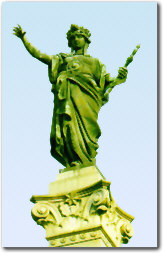
|
|
" ... All that I experienced afterwards had already been in
Roustchouk"
Elias Canetti
|
|
|
|

|
Rousse is the biggest Bulgarian
port town on the bank of the river Danube. After the opening of the Rhein
- Main - Danube canal which covers 3,500 km and connects thirteen European
countries with the Near and Far East via the Black Sea, the river becomes
the longest inland waterway on the planet.
|
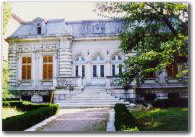
|

|
This key position has determined
the nineteen century long co-existence of town, river, and people, carrying
the unique atmosphere of history as a precious heritage, and of future
as an o pen road full of promises. The Romans were the first to build the
fort which they called Sexaginta Prista (the port of sixty ships). Then
came others, from Europe, leaving their indelible imprint in this intersection
of material and spiritual culture, followed by the imbued with the zeal
of drive and enterprise Bulgarians, who gradually turned the place into
a centre of the Bulgarian national revival. The very name Rousse became
a synonym of economic growth and cultural rebirth.
|
 |

 |
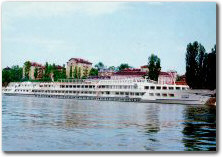 The nineteenth century saw here the opening of the
first Bulgarian printing house, the first model farm, the first Bulgarian
railroad connecting Rousse with Varna, the first Bulgarian weather service,
the first technical school and technical society, the first professional
teachers' club, the first insurance agency, the first chamber of commerce
and industry, the first inland navigation service on the Danube, the first
telephone, the first moving picture show, the first Bulgarian newspaper,
the first map of geography.
The nineteenth century saw here the opening of the
first Bulgarian printing house, the first model farm, the first Bulgarian
railroad connecting Rousse with Varna, the first Bulgarian weather service,
the first technical school and technical society, the first professional
teachers' club, the first insurance agency, the first chamber of commerce
and industry, the first inland navigation service on the Danube, the first
telephone, the first moving picture show, the first Bulgarian newspaper,
the first map of geography.
|
|
|
|

 |
New industries
sprang up, banks and trade agencies were founded and European shipping
agencies, as well as 17 foreign consulates were established. A large number
of Bulgarian, Austrian, Italian, and Swiss men of art created the wealth
of architectural forms and styles characteristic of the period in Europe:
neoclassicism, neobaroque, neogothic style, art nouveau, and fin du siecle.
|

The town hosted
a vast variety of multinational ethnic groups which the Nobel writer Ellias
Canetty defined as a microcosmos of two dozen nationalities. French, German,
Italian, Jewish, Armenian, Turkish, and other schools, boarding houses
and churches, reading clubs, theatres and music halls, museums and bookshops,
opened their doors to help diversify the cultural life of the city in its
steady march towards enlightment. in this completed picture of social life,
today the town is still rediscovering its true face, spanning a bridge
across cultures in the new context of integrated Europe
|
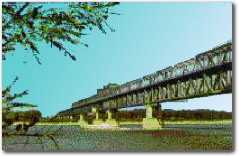 |

|
THE HISTORY OF ROUSSE
|
 |

The high bank
at Rousse was very convenient for man in the 4-th millennium BC. As the
tell was most typical of the prehistoric settlement, that found at the
present sugar refinery, 13 metres high, 20 metres wide and 70 metres long,
it enclosed stratigraphic evidence from three ages of prehistory: the Stone,
Bronze and Copper Age. As Rousse district had early inhabitants and a very
eventful history, it was a real Eldorado for archaeological expeditions
whose successful work throughout the years has materialized in the Archaeological
Museum that Karel and Herman Skorpil created. The famous treasure from
Borovo is the most valuable exhibit.
Thracians of the tribe Getae settled
in Rousse district in the 6-th century BC; it was not long before they
felt the Roman expansion for the empire built up a military presence in
the basin of the Lower Danube year after year. While Nero was the emperor
the legions here were five; a century later Marcus Aurelius made them 12.
The ancient station must have been established under Vespasianus (69-79).
The Roman name of the city was Sexaginta Prista, the Port of the Sixty
Ships. That name occurs on a Roman inscription of 100-101 and on the milestones
from the period of the emperors Antonius Pius, Marcus Aurelius and Aurelianus.
The stones marked where the main roads started from the fort - to Marcianopolis,
Nove and Durostorum. Excavations have produced evidence that during Trajanus'
campaign against the Dacians that was the main base of his warships. Sexaginta
Prista was put on the Roman map of military routes Tabula Pointingeriana
that Marcus Agrippa drew in the 1-st century. A copy of that map has been
found in the Calmar Monastery in Southern Sweden. The geography of Claudius
Ptolemy, an Alexandrian geographer who lived during the reign of Marcus
Aurelius and who is mentioned in the Constantinopolitan "Historia Ecclesiastica",
gives an extensive description of the city. Procopius of Caesarea has also
recorded it. Prista is the name used in the Notitiae Tagniatum of the anonymous
cosmographer from Ravenna. In the 6-th century Justinian solidly fortified
it and the place became a key component of the Byzantine defence system
which, however, surrendered to the barbarian waves. For centuries after
the woeful shadow of destruction haunted the place and there was not a
city.
The Bulgarian feudal state had an
economy in kind and insignificant trade, so the settlement on the big river
was almost derelict. The fort was in Cherven and the fortification was
similar to that in Veliko Turnovo. It was the centre of the fortified areas
in the basin of the Roussenski Lom where Skorpil counted 48 forts altogether.
Evidently the city that was re-established on the site derived its present
name from Cherven four "rous" is a synonym of "cherven" (red) which is
an adjective in all Slavic languages and cognate to the Latin "rusos" and
the French "rouge". The Turks who liked the city very much used a diminutive
form, Roustchouk. After the conversion of Bulgaria to Christianity Cherven
became the see of a bishopric and was in its heyday in the 14-th century;
a watch tower, remains of a citadel, streets, 11 churches, cisterns and
a tunnel to a karst spring have survived. Cherven was a famous centre of
arms production and of brisk trade where many foreigners arrived, mainly
from Dubrovnik. In the 13-th century king Ivan Assen granted many privileges
to them and addressed them as beloved and faithful guests of the kingdom.
It was one of the few traditions that the Turkish invaders adopted: many
Turkish documents mention the Dubrovnik colony in the area; those people
paved the way to the Catholic presence and had their own houses of prayer.
The lovely Catholic church of St Paul built in 1892 to the design of the
architect Valentino who is to be credited for the Catholic church in Varna
as well was their successor. For the first time organ music was played
in Bulgaria there; the instrument with 700 pipes was made in Germany. The
church interior is impressive for the stained glass made in Budapest, the
crystal chandeliers and the abundance of icons.
The valley of the river Roussenski
Lom abounds in remarkable rock monasteries; over 300 premises of which
40 were used as rock churches have survived. There is plenty of evidence
that they must have been at least twice that number. The ravages of time,
ignorance and religious intolerance have abolished most of them. Yet what
remains is enough to admit and it will be admitted that the rock cloister
and the frescoes in it are unique. That is why they have been evaluated
as an important stage in the development of European culture and recorded
on the UNESCO List of World Cultural Heritage. The Ivanovo Monastery has
seven churches; the oldest part is on the right bank, around the Buried
Church; the premises are large, here and there 5 x 5 metres and their walls
have been nicely tailored. The Laura, the core of the big monastery compound,
was there. To the east are the cells around the Lord's Ravine; the Church
is in a best state of preservation. The vault is not flat; it is semicylindrical,
like that of the Bessarbovski Monastery. The Ivanovo churches contain some
of the best frescoes of Bulgarian religious art. They are down-to-earth,
vigorous and artistic, lending a human approach to the dogmas, employing
means of expression that relate them to the new aesthetic and moral values
of the coming European humanism. For the first time in its more recent
history Rousse is mentioned in the 1502 peace treaty between the Turks
and Hungarians. From the second half of the 16-th century onwards it started
developing as an economic, military and strategic centre of primary importance.
In 1580 Pavel Jorjic described Rousse at length; in 1640 the Franciscan
friar Peter Baksic from the Bulgarian town of Chiprovtsi who was to become
a Catholic bishop wrote that there were 3000 Orthodox houses, 200 Turkish
houses and 200 houses of other nations. Again at that time Hadji Kalfa
counted 6000 houses, a fort, a customs house and nine mosques.
Travellers like Carsten Nibur in
1767 and Nicholas Kleeman in 1768 mentioned the lovely view of the city
and its commercial importance. Evliya Chelebi wrote thus: "There are 2200
one- and two-storey houses in the city. Real palaces amidst gardens are
usually on the bank of the Danube. There are three Christian neighbourhoods,
a primary school, three inns, a bath and 300 shops." Rousse was mentioned
in the travel notes of the great friend of children, Hans Christian Andersen.
The Rousse fort which was encircled by a moat that was 8 metres deep and
15 to 25 metres wide aroused everybody's admiration; the walls rose 10
metres over the river; there were five gates to come in and go out, each
with a bridge and a cart waiting for each destination; the invincible Levent
Tabia was the most significant of the fortifications on the hills around.
Under Mithad Pasha, one of the most
illustrious names in Turkish national history, Rousse was in its heyday.
In 1858 he visited Paris, London, Brussels and Vienna to see for himself
the political, economic and cultural state of the European countries. Six
years later he became the governor of the Tuna Vilayet, the Danube province
and the largest province of the empire, comprising all North and West Bulgaria,
with Toulcha, Varna, Rousse, Turnovo, Vidin, Nish and Sofia. The period
of the reform-minded man saw the construction of 3000 km of roads and 1140
bridges of which was the famous bridge of Kolyo Ficheto in Byala, a real
miracle of construction, 300 metres long and 10 metres wide, on the major
road of the province; the self-taught genius decorated the piers that were
sharpened on the side facing the current with purely Bulgarian heraldic
motifs: elves, double-headed eagles, lions and swans.
Communities were organized; measures
were taken to promote trade and industries; land cultivation in the Obraztsov
Chiflik estate became mechanized; new sweet-smelling vine grape varieties
from Asia Minor were introduced. The strong resistance that his innovations
met made him particularly inventive. To build straight and broad streets
he caused several fires the worst of which was on July 29, 1868. The receipts
from the fees for the fair in Turgovishte were used to establish a shipping
company; the income from the maize grown on the common
land was used to open a bank.
 Mithad Pasha built two big European-style hotels: Royal Rose and House
of Reform. Beside islahhane, the building that later was to be the Russian
military club, the mayor's office and a pupils' boarding house, the home
of Kaliopa Kalish who was rumoured to be the pasha's mistress has survived.
Today it is the urban lifestyle museum which displays a rich collection
of furniture, services and fashion in a lovely interior of a house that
was lavishly decorated by the artist Karl Steinberger in 1883. And as the
150 lanterns that had been brought from Vienna were fewer than what was
required in the pasha's opinion, he added a red lantern, the first brothel
in the empire.
Mithad Pasha built two big European-style hotels: Royal Rose and House
of Reform. Beside islahhane, the building that later was to be the Russian
military club, the mayor's office and a pupils' boarding house, the home
of Kaliopa Kalish who was rumoured to be the pasha's mistress has survived.
Today it is the urban lifestyle museum which displays a rich collection
of furniture, services and fashion in a lovely interior of a house that
was lavishly decorated by the artist Karl Steinberger in 1883. And as the
150 lanterns that had been brought from Vienna were fewer than what was
required in the pasha's opinion, he added a red lantern, the first brothel
in the empire.
Mithad proclaimed
Bulgarian as a co-official language and recognized that the law should
make no discrimination between the Turks and non-Turks. Subtle as this
assimilatory policy was and not entirely efficient because of oriental
fanaticism and laziness, as a matter of fact it sought to denationalize
the Bulgarian population who made up one twentieth of the Turkish empire
but accounted for one third of Turkey's economic potential; the rest was
generated in the 16 other districts that were far less developed.
In the long run the attempt was
abortive and the rebellious Bulgarians in fact interrupted Mithad's Rousse
career. Recalled after the energetic interference of the Russian ambassador
count Ignatieff he had to say adieu to the city and returned only for a
little while to organize the destruction of the heroic detachment of Hadji
Dimiter and Stefan Karadja. Afterwards his path was tortuous: he was the
governor of Crete, Damascus and Smyrna, he was a grand vizier, he was an
emigre, he was sentenced and pardoned and then in 1884 the sultan Abdul
Hamid ordered that he was strangled and the severed head was shown to him
to make sure that this time the agile actor failed to outplay him.
When the sultan Abdul Mejid visited
Roustchouk each of the subjects could approach him with a petition. The
Bulgarians did and so did the Turks. The sultan was angry: "Couldn't you
think of something else but fountains? Is the Danube too little for you?
Look at the Bulgarians; they want Bulgarian bishops and Bulgarian schools!"

The first Bulgarian monastery school was opened in 1820,
the first secular school was opened in 1842.
It took two years to build the schoolhouse
and the Rousse-born A. Hadjiroussev donated the first Bulgarian geographic
map that he had published in Strasbourg. In 1850 there were ten schools
in Rousse where 900 schoolboys and schoolgirls were taught by 11 school
masters and six school mistresses.
 The Bulgarian community was established in 1865; the Zora reading club
was opened in 1866; the first Bulgarian printing press with a modern Keiser
machine and 10,000 kilograms of Bulgarian and Turkish types was opened
in 1866 again. The city became one of the busiest Revival centres of book
printing; till 1870 alone 86 Bulgarian books were printed. The Lyra singing
society was founded at about the same time; the choir was singing in Trinity
Church which was the oldest and the largest in the city and which was built
in 1632 and rebuilt in 1764. Outside it looked low and dug into the ground,
to meet the Turkish canon but inside it was astonishing for the magnificent
altar and excellent acoustic. The belfry was built in a later period for
the Turks in Rousse did not allow to ring the bells to call the congregation
so there were special people who struck the street pavement with iron-studded
crooks. 1871 will be remembered for the first Rousse orchestra; the first
performance of the play "Lost Stanka" was again in that year.
The Bulgarian community was established in 1865; the Zora reading club
was opened in 1866; the first Bulgarian printing press with a modern Keiser
machine and 10,000 kilograms of Bulgarian and Turkish types was opened
in 1866 again. The city became one of the busiest Revival centres of book
printing; till 1870 alone 86 Bulgarian books were printed. The Lyra singing
society was founded at about the same time; the choir was singing in Trinity
Church which was the oldest and the largest in the city and which was built
in 1632 and rebuilt in 1764. Outside it looked low and dug into the ground,
to meet the Turkish canon but inside it was astonishing for the magnificent
altar and excellent acoustic. The belfry was built in a later period for
the Turks in Rousse did not allow to ring the bells to call the congregation
so there were special people who struck the street pavement with iron-studded
crooks. 1871 will be remembered for the first Rousse orchestra; the first
performance of the play "Lost Stanka" was again in that year.
That same year
saw a far more remarkable event: Angel Kunchev set up a secret revolutionary
committee. The Tryavna-born man had enviable education by the then standards:
first he graduated from the artillery school in Belgrade and then from
the famous agricultural school in the Czech city of Tabor. He might have
had a brilliant career as the manager of Obraztsov Chiflik. However, he
chose a different life: be became the leader of organized revolutionary
activity and on his way to Romania he was betrayed and committed suicide
rather than surrender to the enemy alive at the port of Rousse. He was
an honest, devoted and brave man, just like the Apostle of Freedom Vassil
Levski who had signed his powers.
The tomb of 453 activists from Rousse
who were involved in the national liberation struggles is in the Pantheon
of the Revivalists, a cube with a gilted roof in the city centre. The monument
is not to the liking of everyone but everyone pays homage to their lifework.
Among all Granny Tonka Obretenova, the first woman who was a member of
the organization, is the most striking personality. Intelligent and firm
she dedicated all her nearest and dearest to the Liberation of Bulgaria:
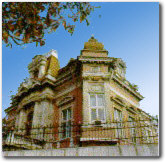 two
of her sons perished in the struggle; her other two sons were sentenced
to be convicts for life yet she never shed a tear and was always determined
to put up the men, to give them food and cure and to guard them. It was
she who unearthed the head of Stefan Karadja who died on the gallows and
saved it for the generations to come as a relic. Granny Tonka treated Zahari
Stoyanov as a son before he became a son-in-law. That man's lifework was
memorable for Bulgaria: he was a chairman of the National Assembly and
an initiator and organizer of the Reunification in 1885. However he is
mostly remembered as the author of the immortal "Notes on the Bulgarian
Uprisings". Today two museums which are next door have brought these two
together forever and familiarize in detail with the life and time of these
eminent Bulgarians. two
of her sons perished in the struggle; her other two sons were sentenced
to be convicts for life yet she never shed a tear and was always determined
to put up the men, to give them food and cure and to guard them. It was
she who unearthed the head of Stefan Karadja who died on the gallows and
saved it for the generations to come as a relic. Granny Tonka treated Zahari
Stoyanov as a son before he became a son-in-law. That man's lifework was
memorable for Bulgaria: he was a chairman of the National Assembly and
an initiator and organizer of the Reunification in 1885. However he is
mostly remembered as the author of the immortal "Notes on the Bulgarian
Uprisings". Today two museums which are next door have brought these two
together forever and familiarize in detail with the life and time of these
eminent Bulgarians.
The Russian troops seized Rousse
on February 8, 1878. The Turkish mayor had already fled taking with him
the keys to the city and the banner. The treasurer Ahmed Hamdi tried to
find someone to whom he could surrender the power and evidently he became
a member of the municipal council afterwards. Everyone was waiting for
the happy event but some were making preparations. Vassil Souradev, for
example, overstocked his warehouse with thousands of hats and when the
slaves gave vent to their jubilation first by throwing down the fezes,
he simply had a good business.
The 1880 general census showed that
with a population of 26,163 Rousse was the largest city of the Principality.
The earliest city plan of the Russian military engineers Ozhio and Kopitkin
was from the first days of freedom; it was redeveloped in 1895 by engineer
Dovish and for almost two decades Edouard Winter was the city architect.
The first telephone conversations were heard in 1895 when the old Sofia
exchange was installed. Special tiles were brought from Bucharest for the
curbstone; the main streets were paved with stones that were bought from
France. The first car appeared in 1911; in the next 15 years the number
increased to 14; the first electric bulbs were switched on in 1916; the
buses arrived in 1925. Rousse was the most industrialized centre of Bulgaria
with seven of the 20 factories. The raw materials were usually imported
and sometimes they went to the extreme: for instance, the hat factories
which were the largest in the country used even imported straw. Big investments
were made in the food industry where a sugar refinery whose capital was
10 million Belgian francs whose fleet of barges and tug boats was larger
than that of the state was the key enterprise. The refinery had its own
quay and rope line and provided employment to 1700 workers. However it
was they who dominated; more than 20 per cent of the active population
were in trade.
|





 The nineteenth century saw here the opening of the
first Bulgarian printing house, the first model farm, the first Bulgarian
railroad connecting Rousse with Varna, the first Bulgarian weather service,
the first technical school and technical society, the first professional
teachers' club, the first insurance agency, the first chamber of commerce
and industry, the first inland navigation service on the Danube, the first
telephone, the first moving picture show, the first Bulgarian newspaper,
the first map of geography.
The nineteenth century saw here the opening of the
first Bulgarian printing house, the first model farm, the first Bulgarian
railroad connecting Rousse with Varna, the first Bulgarian weather service,
the first technical school and technical society, the first professional
teachers' club, the first insurance agency, the first chamber of commerce
and industry, the first inland navigation service on the Danube, the first
telephone, the first moving picture show, the first Bulgarian newspaper,
the first map of geography. 


 Mithad Pasha built two big European-style hotels: Royal Rose and House
of Reform. Beside islahhane, the building that later was to be the Russian
military club, the mayor's office and a pupils' boarding house, the home
of Kaliopa Kalish who was rumoured to be the pasha's mistress has survived.
Today it is the urban lifestyle museum which displays a rich collection
of furniture, services and fashion in a lovely interior of a house that
was lavishly decorated by the artist Karl Steinberger in 1883. And as the
150 lanterns that had been brought from Vienna were fewer than what was
required in the pasha's opinion, he added a red lantern, the first brothel
in the empire.
Mithad Pasha built two big European-style hotels: Royal Rose and House
of Reform. Beside islahhane, the building that later was to be the Russian
military club, the mayor's office and a pupils' boarding house, the home
of Kaliopa Kalish who was rumoured to be the pasha's mistress has survived.
Today it is the urban lifestyle museum which displays a rich collection
of furniture, services and fashion in a lovely interior of a house that
was lavishly decorated by the artist Karl Steinberger in 1883. And as the
150 lanterns that had been brought from Vienna were fewer than what was
required in the pasha's opinion, he added a red lantern, the first brothel
in the empire. 
 The Bulgarian community was established in 1865; the Zora reading club
was opened in 1866; the first Bulgarian printing press with a modern Keiser
machine and 10,000 kilograms of Bulgarian and Turkish types was opened
in 1866 again. The city became one of the busiest Revival centres of book
printing; till 1870 alone 86 Bulgarian books were printed. The Lyra singing
society was founded at about the same time; the choir was singing in Trinity
Church which was the oldest and the largest in the city and which was built
in 1632 and rebuilt in 1764. Outside it looked low and dug into the ground,
to meet the Turkish canon but inside it was astonishing for the magnificent
altar and excellent acoustic. The belfry was built in a later period for
the Turks in Rousse did not allow to ring the bells to call the congregation
so there were special people who struck the street pavement with iron-studded
crooks. 1871 will be remembered for the first Rousse orchestra; the first
performance of the play "Lost Stanka" was again in that year.
The Bulgarian community was established in 1865; the Zora reading club
was opened in 1866; the first Bulgarian printing press with a modern Keiser
machine and 10,000 kilograms of Bulgarian and Turkish types was opened
in 1866 again. The city became one of the busiest Revival centres of book
printing; till 1870 alone 86 Bulgarian books were printed. The Lyra singing
society was founded at about the same time; the choir was singing in Trinity
Church which was the oldest and the largest in the city and which was built
in 1632 and rebuilt in 1764. Outside it looked low and dug into the ground,
to meet the Turkish canon but inside it was astonishing for the magnificent
altar and excellent acoustic. The belfry was built in a later period for
the Turks in Rousse did not allow to ring the bells to call the congregation
so there were special people who struck the street pavement with iron-studded
crooks. 1871 will be remembered for the first Rousse orchestra; the first
performance of the play "Lost Stanka" was again in that year.  two
of her sons perished in the struggle; her other two sons were sentenced
to be convicts for life yet she never shed a tear and was always determined
to put up the men, to give them food and cure and to guard them. It was
she who unearthed the head of Stefan Karadja who died on the gallows and
saved it for the generations to come as a relic. Granny Tonka treated Zahari
Stoyanov as a son before he became a son-in-law. That man's lifework was
memorable for Bulgaria: he was a chairman of the National Assembly and
an initiator and organizer of the Reunification in 1885. However he is
mostly remembered as the author of the immortal "Notes on the Bulgarian
Uprisings". Today two museums which are next door have brought these two
together forever and familiarize in detail with the life and time of these
eminent Bulgarians.
two
of her sons perished in the struggle; her other two sons were sentenced
to be convicts for life yet she never shed a tear and was always determined
to put up the men, to give them food and cure and to guard them. It was
she who unearthed the head of Stefan Karadja who died on the gallows and
saved it for the generations to come as a relic. Granny Tonka treated Zahari
Stoyanov as a son before he became a son-in-law. That man's lifework was
memorable for Bulgaria: he was a chairman of the National Assembly and
an initiator and organizer of the Reunification in 1885. However he is
mostly remembered as the author of the immortal "Notes on the Bulgarian
Uprisings". Today two museums which are next door have brought these two
together forever and familiarize in detail with the life and time of these
eminent Bulgarians.